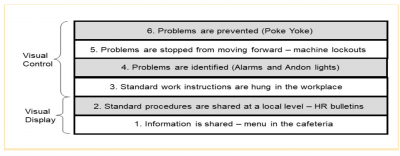
Key Points
- Visual controls are a means of signaling and controlling potential issues in your production.
- Displays are similar in concept but aren’t indicators of process status.
- Visual controls can be color-coded for quick analysis of process status.
As technology becomes more sophisticated, many production lines are running with fewer and fewer people. Unfortunately, when things go wrong, the process still requires intervention and correction by a person.
In this article, we will discuss what we mean by visual controls, their benefits, and best practices, and provide an example where a bigger problem was prevented by the use of visual controls.
What Are Visual Controls?

Visual controls are a subset of the larger concept of visual management. Visual management is a process by which information is conveyed via visual means rather than aural, written, or any other way people communicate.
- Visual displays convey information, for example, utilizing posters, diagrams, maps, and signs. They share information but do not provide any direction or instruction as to what action should be taken.
- Visual controls also convey information, but they also provide direction as to what action to take based on the nature of the visual signal.
A red traffic light provides the information that you need to stop your car. A solid yellow line in the street provides information and an understood instruction that you do not cross over that line. Your car’s odometer just tells you how far you have traveled, but the gas gauge will tell you to head to the closest gas station if needed.
A simple shadow board for tools is a visual control since it provides the direction that the hammer can only go in the space that conforms to the shape of the hammer — and not that of the screwdriver.
Color coding is one of the simplest forms of visual control on equipment. A flashing red light indicates something may not be working as desired and that an inspection and intervention may be necessary. A green flashing light conveys that the equipment is working as planned, and the control action is to do nothing.
The difference between visual displays and visual controls is that visual controls are designed to drive a specific behavior or action. There is a hierarchy of different displays and controls, as represented by the graphic below. This hierarchy can range from simple posters to standard work instructions to a full poka-yoke system.

Are Visual Controls Displays?
I know what you’re thinking, but no a visual control isn’t a display. While similar in concept, a visual control allows you to rectify an issue when signaled. Visual displays only act as indicators of progress, errors, and so forth.
Benefits of Visual Controls
To quote an old phrase, “A picture is worth a thousand words.” Likewise, visual controls are worth a thousand written words. Here are some of the benefits of visual controls.
Easily and Quickly Understand Information
When looking at an Excel spreadsheet, it is quick and easy to spot an issue if the cell is colored red. Cells colored green can be skipped over.
Improve Communications
Assuming that everyone knows that a flashing red light means something has gone awry, everyone should understand what has happened as well as the action needed to correct the situation.
Keep the Flow Moving Smoothly
An overhead sign saying “Enter Here” and another saying “Exit Here” should be able to drive the desired behavior of people entering and exiting in the proper locations for a queue.
Why Are Visual Controls Important to Understand?
Visual controls are a major component of an organization’s overall visual management system. They are a cost-effective and simple way to communicate non-conforming situations so action can be taken.
Safety
Since visual cues are the easiest to understand, actions can be taken before a situation can become dangerous.
Problem Response
You want to have a rapid response system to indications of nonconformity and problems in the system. By understanding what and how a visual control system works, you can address a small problem before it becomes a big one. You can distinguish between the need for correction or corrective action.
Distinguish Between Visual Displays and Controls
Visual displays convey information that is usually nice to know. Visual controls signal when action needs to be taken. You need to understand the difference.
An Industry Example

A producer of orange juice had a process by which an arm swung out to push underfilled cartons off the production line. The equipment was automatic and the line was not regularly manned by an operator. Underfilled cartons were a result of dispensing nozzles clogging due to the pulp in the juice. Unfortunately, there were no visual signals of when the process was deteriorating until the operator heard the sound of juice cartons hitting the floor once the cart overflowed with discarded products.
The team implemented a visual control on the cart once the number of cartons hit a certain number. The sensor would activate a red strobe light above the cart to alert nearby operators that something was going on. Any operator in the vicinity could halt the line.
A secondary visual control was put on the scales that weighed the cartons indicating whether the fill weight was repeatedly falling below the weight spec. Again, it activated a visual signal, but in this case, there was also an automatic shutdown of the machine to prevent further filling of underweight cartons.
Visual Control Best Practices
Visual controls are powerful tools for letting you know about the nonconforming performance of any process. Here are a few tips on using a visual control system.
Use the Appropriate Tool
Be sure that you know when it is appropriate to just use a visual display and when to use a visual control. The key is whether you are just sharing information or want somebody to react and do something.
Agree on What a Signal Means
If you intend to use a visual signal or signage, be sure that everyone has the same definition and knows the required action to be taken in response.
Consider Visual Impairments If Color Coding
Several people have red/green color blindness. Consider any physical conditions that may hinder the appropriate understanding and response to color-coded signals.
Other Useful Tools and Concepts
Looking for other tips and tricks to bolster your organization? You might want to consider looking into discrete data. Data comes in many forms in Six Sigma, but understanding how to quantify qualitative properties is crucial when conducting any sort of analysis.
Additionally, you might want to consider the machine capability index. This short-term index is a great way of seeing how the machines on your production line are performing at the moment. Paying attention to this metric is a great way of determining if a machine is performing as intended.
Conclusion
Visual controls are the quickest and easiest way to signal nonconforming conditions in a process. A visual control is intended to direct a person to a specific action. They are different from visual displays, which are intended simply to share information without a hint of the action that is needed.
In certain situations, you can combine a visual control with sound alerts. Both can provide signals and directions so that workers or participants make the appropriate behaviors, actions, and responses.